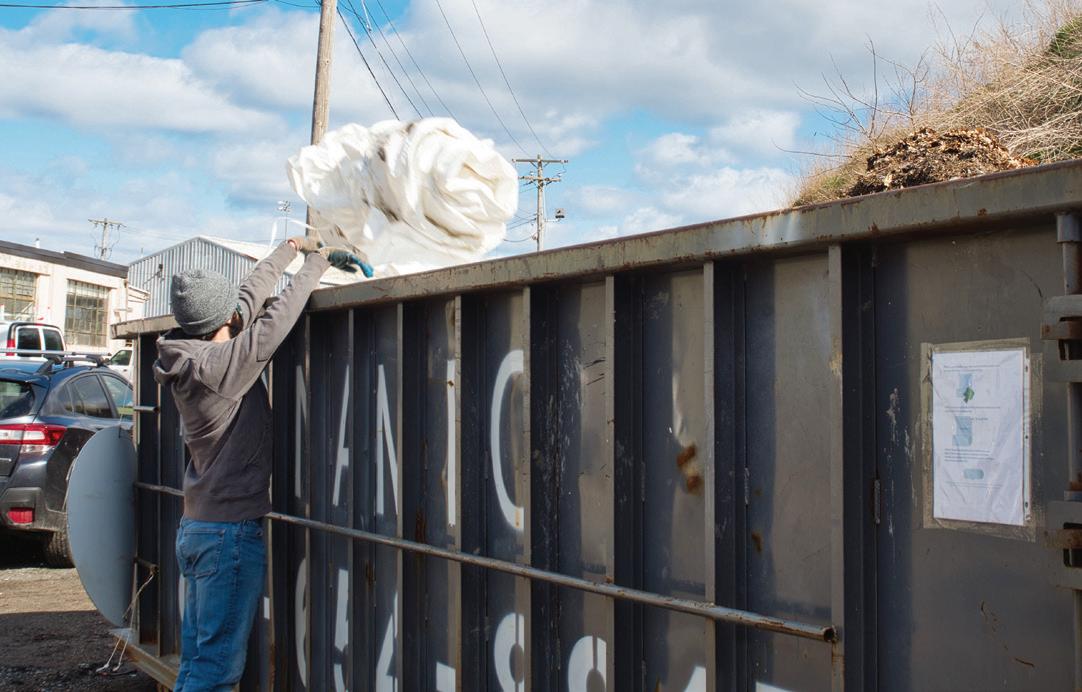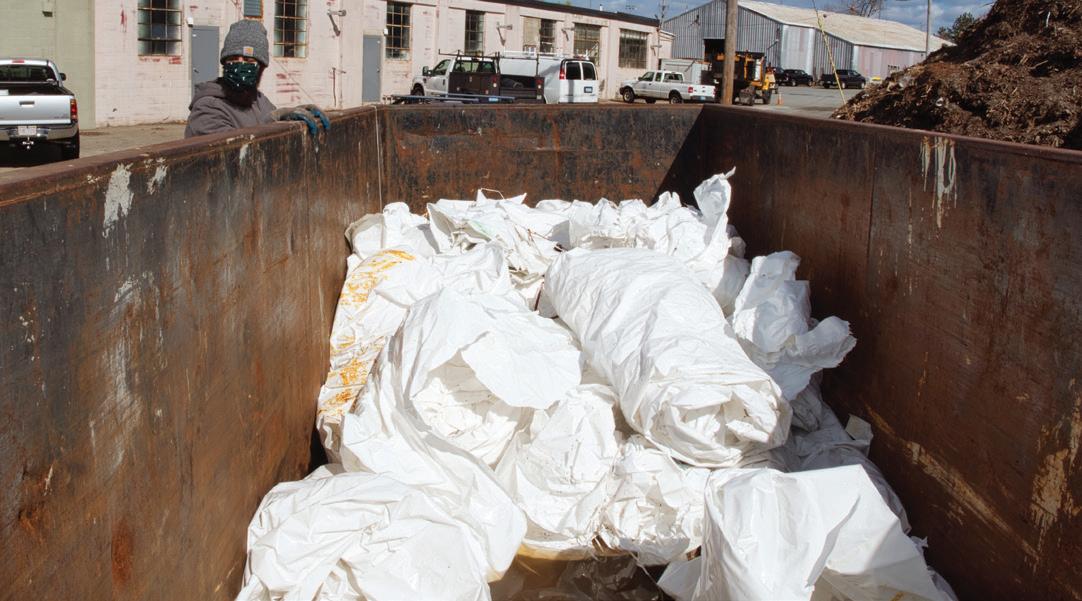
4 minute read
Waste & Recycling
New Massachusetts’ initiative recycles marine shrink wrap
By KATHLEEN MORAN | The Municipal
Gloucester, Mass.’s, new initiative, which ran from early April to early June this year, started with a simple observation.
A sailboat and powerboat wear winter marine plastic shrink wrap coverings at Granite Pier Rockport. (Photo provided) Boats anchor in Gloucester Outer Harbor. (Photo provided)

According to Sean Steinberg, the project manager for Seaside Sustainability, “A Seaside Sustainability board member was driving through his neighborhood and realized the number of parked boats” that would eventually need to be stripped of their winterizing shrink wrap as warmer weather arrived. This important observation led to research investigating ways to recycle marine shrink wrap in a thoughtful and conscientious manner, an objective that resonates with Seaside Sustainability — a nonprofit organization that, as its name implies, is motivated to protect and preserve the ocean through awareness and effort.
This initiative quickly developed as several moving parts began to work collaboratively. One of Seaside Sustainability’s initial steps was to consult with the Woods Hole Oceanographic Institution Sea Grants, which has already had success in running a comparable program on Cape Cod. Additionally, Harbormaster Thomas Ciarametaro confirmed that on March 12, the Harbormaster’s Office agreed to help sponsor the project. A crucial step was the nonprofit’s coordination with the Gloucester Department of Public Works to designate the exact disposal location for Dynamic Solutions in North Andover to deliver the two-month recycling container rental.
The Harbormaster’s Office also “launched a social media campaign to spread awareness of the initiative,” which was key since there were no restrictions for boat owners in terms of residency requirements, said Ciarametaro. It should also be noted that funding for this

Boats anchor in Rockport Harbor. (Photo provided)
initiative was supplemented by a generous contribution on behalf of a family friend of one of Seaside Sustainability’s interns.
Steinberg and Ciarametaro agreed this new Gloucester program was primarily intended to help those who do not store their boats at a marina and/or utilize the various services marinas typically offer, such as preparing a vessel for winter as well as getting it back on the water in warmer months. While many boat owners elect to store their boats at a local marina and take advantage of its available winterization services, others admittedly prefer to assume responsibility of their own vessels.
“While this can be a tedious and unexciting process, it is sure to keep costs down,” stated Steinberg.
It goes without saying that a large amount of shrink wrap is needed to ensure a boat survives the harsh elements of the winter months, and even more shrink wrap is needed depending on the size of the vessel. Unfortunately, the shrink wrap is not suitable for collection via traditional curbside recycling, so all too often, the winterizing shrink wrap is simply disposed of in one’s trash. From there, it is incinerated, which has obvious negative consequences for the environment, explained Steinberg.
The steps required for boat owners to ready their shrink wrap for disposal into the recycling dumpster were simple and easy to follow, allowing for a quick drop-off. Simply put, the shrink wrap was to be clean and free of debris like sand and leaves that may have accumulated and become trapped while a boat sat idle. It was also to be debrided of any wooden supports. Next, the shrink wrap had to be compactly rolled before it was ready to be dropped off.
“Our flyers outlined these specific parameters so that boat owners knew in advance what was expected of them when disposing of their shrink wrap as part of this new program,” said Ciarametaro.
This initiative was met with positive reactions from the public, including podcasts and calls of thanks at the Harbormaster’s Office. Steinberg also noted a positive response from the public, especially given “the direct correlation between clean water and limiting oceanbound plastic.” While specific statistics and information were not collected from boat owners, anecdotal reports reveal some individuals Bundles of marine shrink wrap coverings are stored in a dumpster throughout the collection period. (Photo provided)


After one week, the program collected shrink wrap from nearly 30 boats. (Photo provided)
made a 25- to 30-minute drive in order to responsibly dispose of their winterizing shrink wrap.
“There really is no losing if at least one roll of plastic is diverted from the incinerator,” specified Steinberg.
Fortunately, the recycling dumpster was already half full before the program even came to an end, and the trial run’s success has justified proceeding with the program again next year, with the intention of increasing the number of disposal sites. As the two-month initiative drew to a close, Seaside Sustainability was already thinking ahead to when boat owners would begin to remove their vessels from the water in September. The plan is to provide boat owners with informative discussions that review winterization alternatives to shrink wrap, like non-plastic and reusable options.
“Granted, an alternative such as canvas can easily cost three times that of one year’s winterization services, particularly when factoring in the costs of material and labor, but it will start to pay off after three or four seasons,” clarified Steinberg.
An immediate objective, he elaborated, is to cut down on the production of virgin plastic. The hope is to find a company that will melt down shredded plastic so it can be recycled and turned into new shrink wrap. The ultimate goal is for boat owners to step away from using plastic altogether and instead utilize reusable products.










